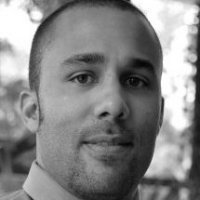On April 6th, 2006 my father passed away from cancer.
Although I had been emotionally prepping for this doomsday, I still could not believe this was happening in my family.
Just two month prior, he was walking around completely fine, and then suddenly, he was about to make an exit. I asked myself, what do I do now? How do I emotionally support and stay strong for my mother and sister? How do I move forward?
I had lots of confusing questions on my mind, but how to plan for the future wasn’t one of them.
I would do anything to take my mind off the future. After discovering my father was terminally ill, the future was bleak and was not something I wanted to face, because I knew what was in store for him. I knew that one day in the near future he would wither away and be out of my life forever.
So, I lift weights to become stronger and build more muscle, and went out to bars, drinking plenty of beer. Yet, I still was unable to address and focus on the real problem—my fear of receiving the same fate. The thought of having cancer plagued my mind.
Would it be better for me to avoid my fear, or to take action and control of my fear? I had been consumed with working out to take my mind off the real problem, however, I did not have control. I was not focusing on eliminating my fears and frustrations, just masking them.
It dawned on me months after my father’s passing that in order for me to thrive, I need to do something. A light bulb went off—before I could move on, I had to invest in my future.
“I cannot deny what I must do anymore, I need to stop focusing on death and start focusing on life!” To do this, “I need to take control of my health.” I needed to learn as much as possible about staying healthy and preventing myself from getting sick!
I started my research online gradually, trying to learn the basics of good health and understanding that the quality of my food matters, which is something I had never considered before. I took supplements and shopped organic whenever possible. To my surprise, health was my foundation for prosperity and growth and getting what I want out of life. Taking the right action and focusing on surpassing the mental barriers I needed to overcome allowed me to unleash my true potential.
Back then, I didn’t know the true importance of having a vision. I always believed if I accomplished any small goal that it was something noteworthy. It didn’t matter if it was in line with my personal vision or not.
Through the years I’ve learned that focusing on doing the right things first, before focusing on the minutiae, manner or method that I do it in, helped me progress my life in the right direction.
Applying focus and creating our “core vision” of who we want to be, how we will give back to others, and what we want in our lives, can help us find and pave our true paths.
Steps on Creating Our Core Vision
Goals are important, but our “core vision” is even more important:
Step 1: Who do we want to be, personally and professionally? How would we like to make our mark on this world? What would we want to be said on our tombstones? Summarize who this person is.
Step 2: What are our core values? These are important values that we strive for and can’t live without. These are values we would want to uphold.
For instance if we went to a new planet and could only take five to 10 values with us, what would they be? Don’t be shy to list values such as power. It is fine as long as it does not violate the rights of others. Keep in mind values can be cool and fun too. They are not just limited to esteemed values like honest and integrity.
Like the ancient wisdom of the Kabbalah suggests, we are, in essence, an object of our own desire. It is important to make sure our values also represent our desires, not just virtues. For instance a CEO may desire power, whereas a monk may desire peace or tranquility.
Believe it or not adventure and having a ball are also values! Some others are learning, spirituality, and connectedness. Like authors Henry Kimsey-House, Karen Kimsey-House and Phillip Sandahl said in the title Coactive Coaching, don’t go shopping for values!
Step 3: Who would we like to associate with? What type of people are these? How will we go about expanding your circle?
As Jim Rohn said, we are the average of the five people we spend most of our time with—wisdom we should take seriously. If in Step 1, we aspired to be a giving person and start a successful charity, then it would make sense for us to associate with people locally who have already done so.
If that’s the case why, hang out with someone who just got out of jail, for example? It is not always a great idea to fully cut someone off who has been good to us, however instead of spending multiple hours with those who are not inspiring us, helping us to succeed, or helping us with our goals, we might want to cut down on the amount of time spent together.
If there is an influential person we would like to get in good with, consider the following:
1. What are they most passionate about?
2. How can we help out with that?
3. Take action and help out the best way that we can in a genuine way only. No faking!
Step 4: What are specific outcome based high level tangible achievements that we would like to accomplish? List these accomplishments. Try using these categories:
1. Health and Fitness
2. Personal Development
3. Family
4. Financial
5. Job or Business
6. Lifestyle
We must make sure that these outcomes are aligned with our “core vision” and “core values.” When we do not align our outcomes with our vision and values, we end up wasting time and losing direction.
For example, if we value honesty and integrity, and we decide that we would like to scam hard-working people out of their money, we clearly have a disconnect. This would cause dissonance, which according to Merriam-Webster is a “lack of agreement; especially: inconsistency between the beliefs one holds or between one’s actions and one’s beliefs.” Dissonance is a horrible thing—please avoid it at all costs.
For each outcome make sure to include:
First: What you want to gain or lose?
Second: How much?
Third: What time frame do you plan on accomplishing this? Our brain is better wired for shorter time frames, such as 90 days. This gives us a greater sense of accomplishment, motivation, and dopamine release, which makes success addictive!
Action Plan: How we will do it!
Only create an action plan for one outcome at a time, so that it is doable. Don’t take on too many at once.
1. Identify the needle.
Identify the one thing, the one baby step that will generally get us moving in the right direction. Keep in mind we are just trying to get started here.
The most important step in accomplishments is getting started, and since our will power is limited, a sensible thing to do is to take that first baby step, like Richard Dreyfuss forced Bill Murray to do in “What About Bob.”
For instance, if we are looking to lose 20 pounds, then the needle could be purchasing a gym membership, hiring a person trainer, or taking your first morning run.
2. Decompose the goal.
Here is where we deconstruct the accomplishments into actionable tasks or steps—actions which are a single, one-time event, or which we take by capitalizing on opportunities. To do this effectively, we must pay attention to where opportunities exist and jump on them instead of hesitating.
We also can research, or ask a mentor or someone who has completed a similar achievement how they did so. This could give us better insight on how to develop the steps for our action plan.
I hope this helps you get the needle moving in the right direction to achieve your desires, values, hopes, and dreams.
Author: Randy Parson
Editor: Catherine Monkman
Photo: Guilherme Yagui/Flickr







Read 0 comments and reply